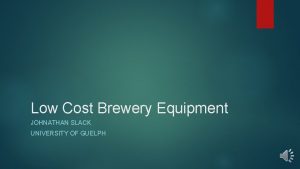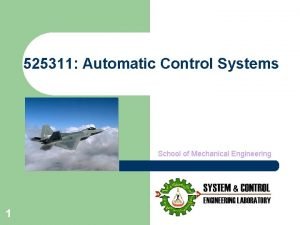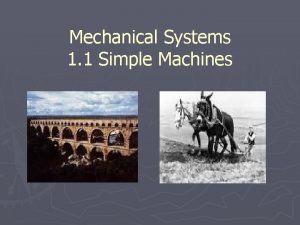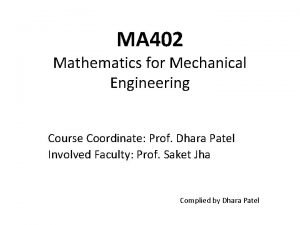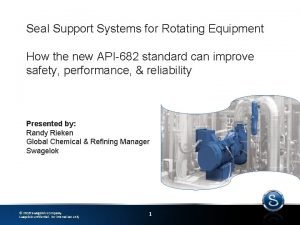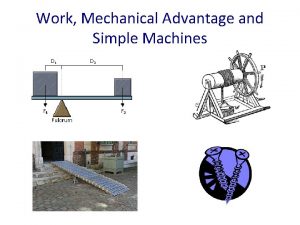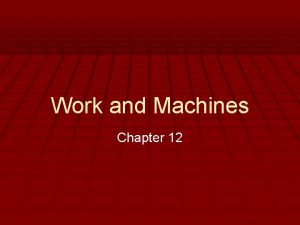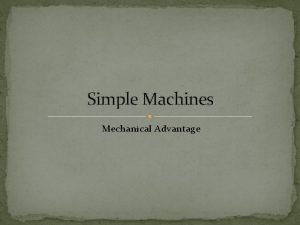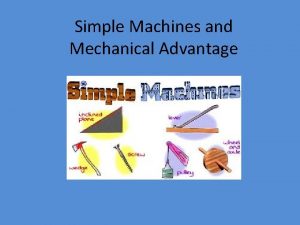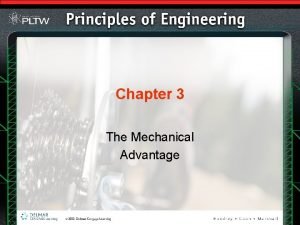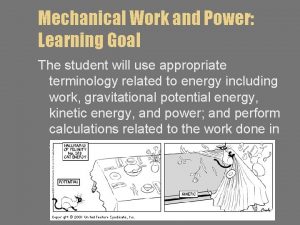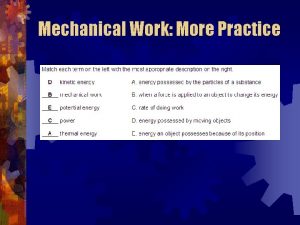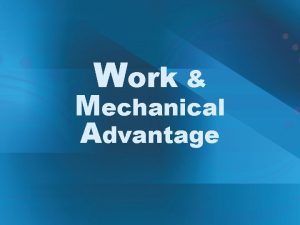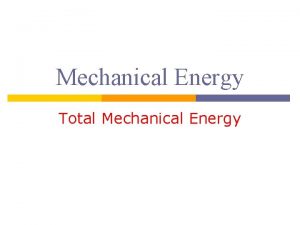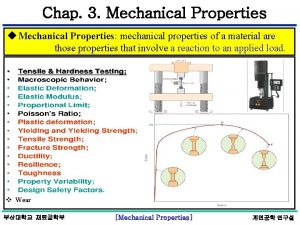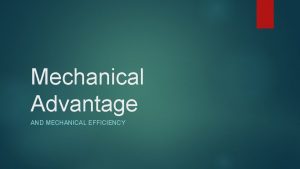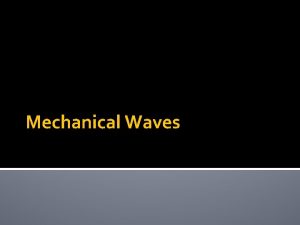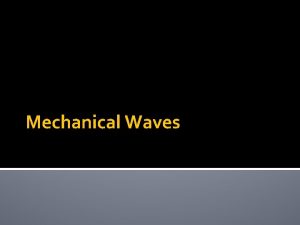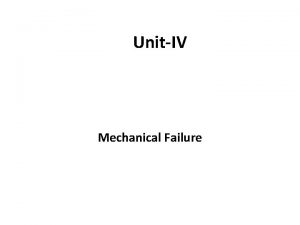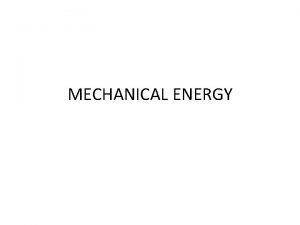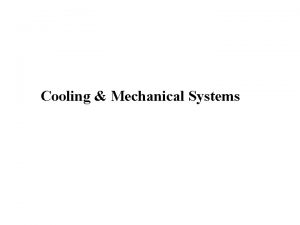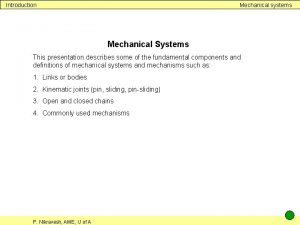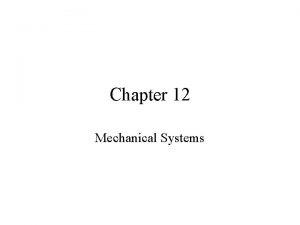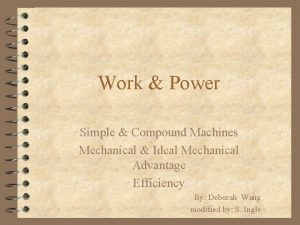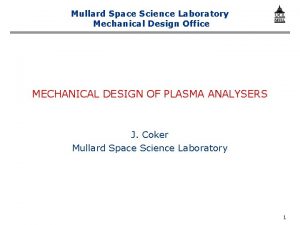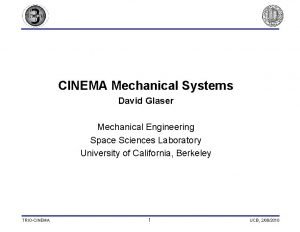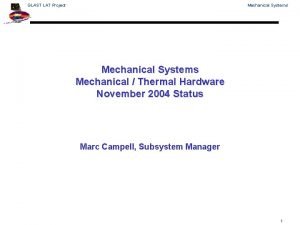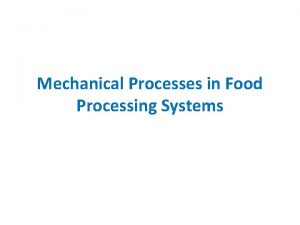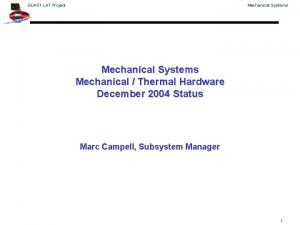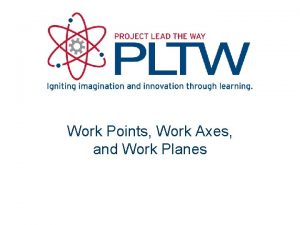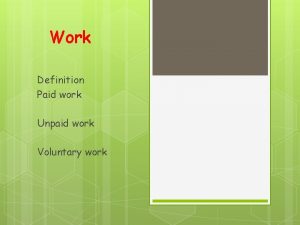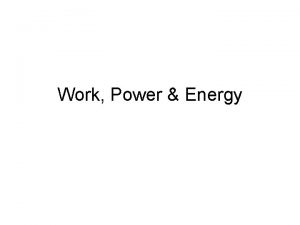Mechanical Systems 2 2 The Science of Work



























- Slides: 27

* Mechanical Systems 2. 2: The Science of Work Textbook pages 287 -292

*In the following 4 scenarios, decide if work is being done. *Write your answer and explanation in the first column.

Scenario 1: A teacher applies a force to a wall and becomes exhausted.

Scenario 2: A book falls off a table and free falls to the ground.

Scenario 3: A waiter carries a tray full of meals above his head by one arm straight across a restaurant at a constant speed.

Scenario 4: A rocket accelerates through space.

*In Physics…. *WORK is done on an object when a FORCE acts on an object to move it a certain DISTANCE. *W = F x d.

*3 things needed for work: *1. *2. *3. There must be a force on an object. There must be a displacement. The force must cause the displacement.

* The Joule is the unit of Work. 1 Joule = 1 Newton x 1 meter 1 J = 1 N*m

* James was the son of a rich beer brewer from England. He was homeschooled until he was 15, when he was taught the fundamentals of chem, physics and mathematics by John Dalton ((another famous British chemist). James Joule was able to test out his theories about heat and energy transfer by giving electrical shocks to his brother and playing with the equipment at the brewery.

Scenario 1: A teacher applies a force to a wall and becomes exhausted. This is NOT WORK. The wall DOES NOT move.

Scenario 2: A book falls off a table and free falls to the ground. This is WORK. A force of gravity acts on the book to displace it down (falling).

Scenario 3: A waiter carries a tray full of meals above his head by one arm straight across a restaurant at a constant speed. This is NOT work. The waiter uses a force to hold the tray up, but the tray moved horizontally across the room. The force DOES NOT cause the displacement of the tray.

Scenario 4: A rocket accelerates through space. This is WORK. There is a force (the expelled gases push on the rocket) which causes it to be displaced through space.

* *A nurse pushes a 700 N patient in a wheelchair 5. 0 m up an inclined plane with a force of 320 N. Calculate how much work the nurse did. W=Fxd W = 320 N x 5. 0 m W = 1600 J This is the INPUT WORK!

* *The height of the ramp is 2. 0 m. *The weight of the patient and wheelchair is 700 N. W=Fxd W = 700 N x 2. 0 m W = 1400 J This is the OUTPUT WORK!

* The ramp was 87. 5 % efficient because some work was lost due to friction!

*Textbook page 292 #1 -9 *

* *Power is the measure of how FAST the WORK is done.

* The Watt is the unit of Power. 1 Watt = 1 Joule/second 1 W = 1 J/s

* *A horse is pulling a cart with a force of 150 N by 10 m every 20 seconds. What is the POWER of the horse? *F=150 N *d=10 m *t= 20 s

* *Energy is the ability to cause a change in motion and do WORK! *Remember, to do WORK… a FORCE must be applied to an object to cause the object to MOVE in the SAME direction as the FORCE.

* *Energy does not have MASS and does NOT take up SPACE!

* 1) KINETIC ENERGY is the energy of motion Examples: cars in motion, people that are moving, particles moving 2) POTENTIAL ENERGY is stored energy due to an objects POSITION or CONDITION Examples: a book held in your arms has gravitational potential energy and an arrow in a stretched bow has elastic potential energy.

*In our universe, energy cannot be created or destroyed. *Energy can be transformed from one form to another, but the total amount of energy in the universe is constant.

* *Forms of energy include chemical, electrical, thermal, light (radiant), mechanical (kinetic & potential) nuclear, sound *Types of Energy

 My favorite school subject
My favorite school subject Actual mechanical advantage vs ideal mechanical advantage
Actual mechanical advantage vs ideal mechanical advantage Technology grade 7 term 3
Technology grade 7 term 3 Mathematical modeling of electrical systems examples
Mathematical modeling of electrical systems examples Johnathan slack
Johnathan slack 525311
525311 Simple mechanical systems examples
Simple mechanical systems examples Vibration engineering
Vibration engineering Seal support system operating
Seal support system operating Kinetic energy and work
Kinetic energy and work Mechanical machine
Mechanical machine How does mechanical advantage work
How does mechanical advantage work How does mechanical advantage work
How does mechanical advantage work Screw simple machine mechanical advantage
Screw simple machine mechanical advantage Ideal mechanical advantage definition
Ideal mechanical advantage definition Mechanical work definition
Mechanical work definition Gravitational potential energy
Gravitational potential energy Hình ảnh bộ gõ cơ thể búng tay
Hình ảnh bộ gõ cơ thể búng tay Ng-html
Ng-html Bổ thể
Bổ thể Tỉ lệ cơ thể trẻ em
Tỉ lệ cơ thể trẻ em Voi kéo gỗ như thế nào
Voi kéo gỗ như thế nào Chụp tư thế worms-breton
Chụp tư thế worms-breton Chúa yêu trần thế
Chúa yêu trần thế Kể tên các môn thể thao
Kể tên các môn thể thao Thế nào là hệ số cao nhất
Thế nào là hệ số cao nhất Các châu lục và đại dương trên thế giới
Các châu lục và đại dương trên thế giới Cong thức tính động năng
Cong thức tính động năng




